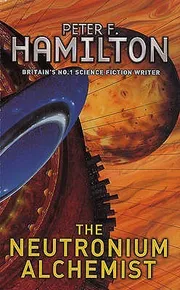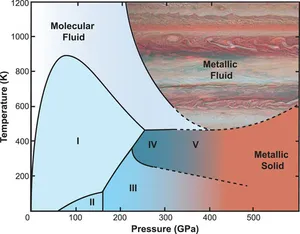Unobtanium, Neutronium and Metallic Hydrogen
One of the key limitations in converting physics theories into practical technology is finding a material capable of taking the forces, temperatures or other physical requirements. Science fiction has, unsurprisingly, hypothesised a variety of such materials - with varying degrees of plausibility.
Unobtainium
A tongue-in-cheek name for such desirable materials was first coined by engineers and scientists rather than writers. Unobtanium, is - by definition - a material which lies beyond reach but which would satisfy some much needed set of criteria. Early uses appeared in technical specifications for the ballistic missile and aerospace industries as a kind of sardonic joke. The term has also been adopted by those studying space elevators - which need a material that combines lightness with high tensile strength beyond our current capacity to produce. However, the irony of the term has also attracted science fiction writers.
David Brin used the name for a rare mineral capable of powering a weapon in his Startide Rising (novel, 1995), and it was used as a nickname for a material which strengthens at high temperature in The Core (film, 2003. dir: Amiel). More famously, however, the material was a central plot driver in the James Cameron blockbuster Avatar (film, 2009). Here it was envisaged as a room-temperature superconductor - able to support powerful enough magnetic fields to levitate mountains. At $20 million per kilogram, the raw ore in this narrative is sufficiently valuable to justify (in the minds of the corporations) strip-mining an entire planet, proceeding by military force despite the objections of the native Na’vi.
![]() This text explicitly asks the question of the value of such materials, and what should be sacrificed to obtain the unobtainable. Here, the Na’vi are the undoubted heroes, defending their culture in the face of militaristic and capitalist imperialism. The material in question is desired for expansion and wealth, not needed for survival. There is little moral ambiguity. However other texts which explore similarly scarce materials sometimes pose more finely-balanced dilemmas - would displacing a community be appropriate, for example, if unobtanium was instead a medical treatment necessary to save millions? Avatar steered comfortably clear of such questions.
This text explicitly asks the question of the value of such materials, and what should be sacrificed to obtain the unobtainable. Here, the Na’vi are the undoubted heroes, defending their culture in the face of militaristic and capitalist imperialism. The material in question is desired for expansion and wealth, not needed for survival. There is little moral ambiguity. However other texts which explore similarly scarce materials sometimes pose more finely-balanced dilemmas - would displacing a community be appropriate, for example, if unobtanium was instead a medical treatment necessary to save millions? Avatar steered comfortably clear of such questions.
Since its appearance in Avatar, the term unobtainium has seen something of a real-world revival, appearing, for example, in the form of digital currency, or as a term for unfindable or expensive replacement parts for ageing technology. Conceptually, unobtanium-by-any-other-name is a common trope in both science fiction and fantasy - with similar essential or desirable but non-existent materials appearing in examples such as Larry Niven’s Ringworld series (scrith), Doctor Who (dalekanium), Stargate SG-1 (naquahdah), the Tom Swift books (Tomasite, Swiftonium), the X-Men (adamantium), and Transformers (cybertronium) amongst many, many others. Nor has professional science been immune from adopting such names. In 1965, Weaver et al published a Nature article on an emission line from an unknown source which they dubbed mysterium "for brevity in writing and to emphasise the surprising nature of the observation".
Neutronium
One material which is often named in science fiction and does indeed exist in nature is neutronium. This is the incredibly dense, incredibly heavy material that, for example, makes up Thor’s hammer Mjolnir in the Marvel comics and cinematic universes [1]. It appeared in scientific literature in the late 1920s, even before the confirmed discovery of the neutron itself. Neutronium has put in appearances in a range of science fiction including E E Doc Smith’s Skylark series (1930), various episodes of Star Trek (1966-1969, 1987-present), John Varley’s The Ophiuchi Hotline (1970) and Alistair Reynolds’ Revelation Space (2000). It is typically described as a solid material either generated naturally by the compression of normal matter in neutron stars or (more rarely) engineered. Indeed, in David Brin's Uplift sequence of novels (starting with Sundiver, 1980), it is manufactured as a side effect of the space-time compression technology used for faster-than-light travel. Either way it is used to provide structural or offensive strength - as, for example, in the hull of “The Doomsday Machine” in the Star Trek episode of the same name (script by Norman Spinrad, 1967).
In some cases, science fiction has actually addressed the natural origin of this material, mined from within neutron stars. Astronomers believe that the collapse of stars under their own gravity at the end of their nuclear-burning lifetimes can result in three different exotic states of matter. The most massive stars collapse until all their mass effectively exists at a point - the resulting gravity is too strong for even light to escape and the structure is known as a black hole. Stars more like the Sun do not have enough mass to collapse in this way. When they begin to contract, their electrons resist being pressed together due to the Fermi exclusion principle (a quantum mechanical effect) and the resultant force balances their self-gravity. The new object formed - supported by electron degeneracy - is known as a white dwarf. For stars between these extremes, the force of electrons is not sufficient support, they continue to collapse until the electrons are rammed together with protons to make material entirely consisting of neutrons. This neutronium (technically a nickname rather than a formal scientific designation) also exerts a quantum mechanical force outwards, pushing the particles apart through neutron degeneracy pressure and resisting further collapse. In the case of neutron stars, this is sufficient to prevent further collapse into a black hole.
 Perhaps unsurprisingly (given the title), this process is actually described and weaponised by Peter F Hamilton in The Neutronium Alchemist (novel, 2008):
Perhaps unsurprisingly (given the title), this process is actually described and weaponised by Peter F Hamilton in The Neutronium Alchemist (novel, 2008):
All electrons and protons within the envelope were crushed together, producing a massive pulse of gamma radiation. The emission faded rapidly, leaving the Alchemist cloaked in a uniform, angstrom-deep ocean of superfluid neutrons.
Plunged into a planet, a chain reaction begins:
The Alchemist had reached the semisolid layers of the gas giant’s interior, and was punching through with almost no resistance. Matter under tremendous pressure was crushed against the device, which absorbed it greedily. Every impacting atom was squeezed directly into a cluster of neutrons that plated themselves around the core. The Alchemist was swiftly buried under a mantle of pure neutronium, which boasted a density that exceeded that of atomic nuclei.
As might be expected, the planet in question does not long survive the experience.
The precise physics of neutronium depends on a poorly-known set of rules called the “equation of state”, which is an active area of research - indeed the equation of state of neutron stars is one of the main areas being probed by the new gravitational wave astronomy which has become possible in recent years. However, despite neutronium indeed being exceptionally dense, it likely does not exist in a solid form at low pressures and room temperatures and so may not satisfy the requirements for strength that most science fiction places on it. It is also likely to be highly unstable in conditions other than under extreme gravity, ejecting neutrons as radiation and converting back into normal matter. Even if it could be mined, it’s unlikely that Odin, for example, could make Thor’s hammer of it. Depending on the equation of state, Mjolnir would likely weigh somewhere between a few billion tonnes and a fair fraction of the mass of the entire Earth [see again note 1]. While this might only be equivalent to adding a new mountain to the Earth’s surface, it would still cause deformation of the Earth’s crust, earthquakes and other disasters. Dropping that hammer would be a Very Bad Idea.
Metallic Hydrogen
A third such desirable substance which appears in science fiction, and again one with some reality in the real world, is metallic hydrogen. This name appears, at first sight as a contradiction in terms: in normal human conditions of temperature and pressure hydrogen is a gas. However in the extremely high pressures found, for example, in the cores of gas giant planets, it can be forced into a phase between solid and liquid. In this state, the hydrogen atoms are closely packed, but their electrons (rather than being tightly bound to individual atoms) are shared between protons in a fairly mobile sea - a property of metallic solids. Thus metallic hydrogen is a highly effective superconductor, and its motions are responsible for the magnetic fields of the gas giant planets. It could be an effective fuel for nuclear fusion. It is also potentially an extremely powerful rocket propellant, combining high energy content with low weight - if a stable enough form can be found, and held under the exceptionally high pressures required [2].

[Figure: An illustrative phase diagram of hydrogen indicating the pressures and temperatures required to create the metallic state. source: Gregoryanz et al, Matter and Radiation at Extremes 5, 038101 (2020)]
Since the existence of metallic hydrogen was predicted in 1935, it has been pursued both in physics experiments and in science fiction. The hard SF writer Alistair Reynolds (as usual) presents an accurate and up-to-date view of metallic hydrogen in his Redemption Ark (novel, 2002), although doing so while still making it usable forces him to hypothesise a foam-like phase unknown to current science:
"The Demarchists mined hydrogen from the oceanic hearts of gas giants. Under conditions of shocking pressure, hydrogen underwent a transition to a metallic state a little like mercury but thousands of times denser. Usually that metallic state was unstable: release the confining the pressure and it would revert to a low-density gas. The foam phase, by contrast, was only quasi-unstable; with the right manipulation it could remain in the metallic state even when the external pressure dropped by many orders of magnitude."
Of course the very different environments of a metallic hydrogen gas giant core may open new windows for habitability - although it would have to be for life very different to our own. In The Saga of Seven Suns (novel series, 2002-2008) author Kevin J Anderson envisages the hydrogues, a species of aliens who not only live in the metallic hydrogen oceans at the core of gas giants, but are themselves composed of it. Human attempts to mine the material inevitably invoke their wrath - unlike in the Avatar case above, this time the harm is done through ignorance of the aliens' presence, rather than deliberate exploitation.
 The perils of dealing with this unstable material have not been ignored either. The 2002 animated version of Dan Dare: Pilot of the Future developed a story arc around metallic hydrogen mined from the gas giants for use as an energy supply, while recognising its potential as a weapon of war. In the episode “The Surrender of Earth, part 1”, the Mekon’s request for emergency aid (including a power supply) meets from objections from Professor Peabody: “This is insane! After what we went through to keep metallic hydrogen out of the Mekon’s hands, we’re just going to deliver it right to his doorstep?”... “An efficient energy source to some people is a dangerous weapon to hateful little green tyrants!”
The perils of dealing with this unstable material have not been ignored either. The 2002 animated version of Dan Dare: Pilot of the Future developed a story arc around metallic hydrogen mined from the gas giants for use as an energy supply, while recognising its potential as a weapon of war. In the episode “The Surrender of Earth, part 1”, the Mekon’s request for emergency aid (including a power supply) meets from objections from Professor Peabody: “This is insane! After what we went through to keep metallic hydrogen out of the Mekon’s hands, we’re just going to deliver it right to his doorstep?”... “An efficient energy source to some people is a dangerous weapon to hateful little green tyrants!”
Nonetheless in this story a reactor is indeed transported to Venus - only to trigger a catastrophic explosion when the reactor is “accidentally” dropped. The resulting nuclear blast seems, if anything, mild given the circumstances. Like neutronium, metallic hydrogen is highly unlikely to be stable in anything approaching the conditions to be found on habitable planets or in starships.
So why is the existence of these remarkable materials so ubiquitous in speculative fiction and in our visions of the future?
Marvellous materials with miraculous properties are not unique to science fiction. They can arguably be traced back through the mithril and goblin-mail of fantasy and the thunderbolt iron, adamantine and orichalcum of mythology. In many ways they represent humanity’s ability to visualise what is needed well before we can develop the technology required to achieve our goals - the constant striving to realise the possibilities we can currently only imagine. They capture the aspirational nature of science fiction, and its goal of inspiring future innovation. And they also articulate humanity's flat refusal to accept that certain things are impossible - if a material can be envisaged, the reasoning goes, then it can be found or devised. While this reasoning hasn't been entirely borne out by our experience, and the potential of materials such as metallic hydrogen remains untapped to date, it is undoubtedly true that materials science continues to develop rapidly and to innovate, solving problems of the past.
As our understanding of materials science and the differing environments offered by our wide Universe expands, the incredible materials which fall under the umbrella of unobtanium now lie tantalisingly on the wavering threshold between science and SF.
“Unobtainium, Neutronium and Metallic Hydrogen”, Elizabeth Stanway. Cosmic Stories blog, 30th October 2022.
Notes:
[1] Marvel fans may know that Mjolnir is sometimes also described as being made by a mystical metal called Uru (a.k.a. unobtanium by any other name) instead of neutronium - with some confusion arising from the statement that it was “forged in the heart of a dead star”. To be fair, Mjolnir is also obviously magical and apparently imbued with sentience, while it is wielded by aliens with godlike powers over matter and electricity, so its physical make up may be something of a side issue. [Return to text]
[2] Sitting on the boundary between science and SF, this concept has been explored by Kerbal Space Programme as well as other games such as Mass Effect. [Return to text]
All opinions are my own and do not necessarily reflect the views of the University of Warwick. Images have been obtained from public domain sources online and are used here for commentary and criticism.
